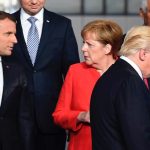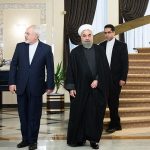by Shervin Malekzadeh
Win or lose, it has become obvious that the fortunes of Hassan Rouhani and his administration remain bound to the memory of 2009 and the Green Movement. Calls for the release of the movement’s imprisoned leaders by the cheering crowds were a constant reminder on the campaign trail that the indignity of Mahmoud Ahmadinejad’s reelection continues to be a source of grievance for millions of Iranians, a legacy to be redeemed at the ballot box. Rather than back down, voters have doubled down in emphatic fashion, electing Rouhani by wide margins in the 2013 and 2017 elections to express their disgust and, above all, to prevent the return of the hardliners.
The impact of eight years of chaos, corruption, and daily crises inflicted by a feckless president who had neither the competence nor the character for office is difficult to overstate. Ahmadinejad has become the ultimate cautionary tale, the incentive to vote, his name an enabling mantra repeated by those who would otherwise never participate in an election. Even as his negative example lifts the prospects of reform, the former president hangs like a millstone around the necks of his erstwhile allies in the principalist camp who are still struggling to distance themselves from his time in office.
Ahmadinejad’s legacy may, however, prove to be as much a burden as a boon to the project of reform. Can the young, middle class, and overwhelmingly female voters who comprise the Rouhani coalition accept losing, which is inevitable in a democracy? Will they take “no” for an answer? Iran’s transition appears to flip the usual script provided by political scientists. Whereas authoritarian states are notorious for their unwillingness to lose elections, in Iran the democratic opposition cannot abide defeat.
The mood on the ground suggests that the majority of Iranians are not yet ready to let go of the recent past, that they still seek their pound of flesh. But democracy requires letting go, accepting the possibility of loss, and moving on to the next round, indeed accepting that there will be a next round. With the leaders of the Green Movement still under house arrest and the violent suppression of their followers still unanswered, it’s understandable that the public remains vigilant. But it is also fair to worry about what will happen if and when the other side fairly wins.
For now, Rouhani supporters are content to celebrate what had once appeared to be a close race and a catastrophe averted. Iran continues her healthy course towards something other than authoritarianism. This election marked the further consolidation of Rouhani’s centrist coalition, an assembly of odd bedfellows and former rivals held together by a commitment to stopping radicalism by winning elections.
For all of the excitement generated by the campaign, 2017 was notable for how routinized the route to victory has become. As in 2013 and 2016, behind-the-scenes coordination between the leadership and activists on the ground proved to be critical, above all in the selection and distribution of a single list of candidates vetted for their acceptability to the system and their likelihood of winning, one of the legacies of the late Hashemi Rafsanjani. As they have since 2009, Iran’s voters demonstrated a commitment to following the path and not the candidate, eschewing the politics of personality that until recently defined Iranian politics. Together, these actions form the basis of what is likely to be a durable movement based on sustainable, democratic norms.
These lessons were not lost on their rivals in the principalist camp. The loser now in two, arguably three, straight presidential elections, Iran’s conservative wing, badly fractured by the Ahmadinejad era, has taken a significant step forward by initiating a new coalition politics. The exit of Tehran mayor Mohammad Bagher Qalibaf in the last week of voting and his endorsement of fellow principalist Ebrahim Raisi signaled an auspicious step in Iran’s political development, as a viable and effective conservative opposition will provide critical ballast to Iran’s domestic politics. If nothing else, it will keep Iran’s democratic movement honest, as evidenced by the scare that the Qalibaf-Raisi alliance gave what had been at times a lethargic Rouhani campaign.
These developments are good news for their constituencies, the more than 16 million Iranians who voted for a principalist of some sort, which represents a consistent 30-40 percent of the electorate. These are the regime’s true believers, the voters most committed to the notion of an Islamic democracy and the values of the revolution. If nothing else, this election has demonstrated that the “hardline” takes diverse form in Iran, that it is impossible to predict someone’s politics based on how they dress, where they live, or their musical interests. Leaving their interests unaddressed will do little to advance the cause of reform and democracy in Iran. Indeed, in his first comments after the election, Raisi asked the government to not ignore his voters, promising that he would continue the “fight against corruption and inequality” on their behalf.
This past Friday, the streets of Iran’s major cities filled with music and dancing, once again transforming much of the country into an “open air party” if only for one night. This too has become part of Iran’s routine, its version of democracy. The celebrations were open to everyone, and no doubt many of Raisi’s supporters joined in the fun, Iran offers so few opportunities for public joyousness and gathering. Effervescent in their delight, they were, as Rouhani noted in his victory speech, for once united as Iranians, made of “one cloth.”
Each election now builds on the previous, in ever accelerating fashion. The vote has become something of a rite of passage for Iran’s youth, a month to look forward to, of celebration, of flirting, of excitement. I wrote after last year’s legislative elections that Iran was becoming more democratic in spite of itself: the illiberal interventions of the Guardian Council inadvertently fostered unprecedented cooperation among rival groups. These short-term remedies have given way to a more profound and long-term commitment. There is no way to watch the scenes from Tehran, Tabriz, and Mashad and not think that democracy has become the thing itself, that Iran has become more democratic because of itself.
Photo: Mohammad Bagher Qalibaf and Ebrahim Raisi






There’s absolutely no basis to say that the election had anything to do with the so-called “Green Movement” nor is there an iota of evidence that the 2009 elections were in any way fraudulent. The fact is that Mousavi was not a dissident or a regime-opponent, he was in fact a hardline former Prime Minister, a regime-insider, whose candidacy was vetted and approved by the same regime that is claimed engaged in massive electoral fraud to keep him out of office.